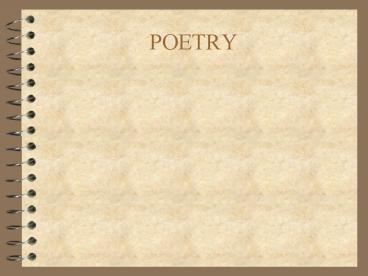POETRY - PowerPoint PPT Presentation
1 / 15
Title:
POETRY
Description:
POETRY POETRY A type of literature that expresses ideas, feelings, or tells a story in a specific form (usually using lines and stanzas) POINT OF VIEW IN POETRY POET ... – PowerPoint PPT presentation
Number of Views:109
Avg rating:3.0/5.0
Title: POETRY
1
POETRY
2
POETRY
- A type of literature that expresses ideas,
feelings, or tells a story in a specific form
(usually using lines and stanzas)
3
POINT OF VIEW IN POETRY
- POET
- The poet is the author of the poem.
- SPEAKER
- The speaker of the poem is the narrator of the
poem or the one telling the story.
4
POETRY FORM
- LINE - a group of words together on one line of
the poem - STANZA - a group of lines arranged together
- A word is dead
- When it is said,
- Some say.
- I say it just
- Begins to live
- That day.
5
SOUND EFFECTS
6
RHYTHM
- The beat created by the sounds of the words in a
poem - Rhythm can be created by meter, rhyme,
alliteration and refrain.
7
METER
- A pattern of stressed and unstressed syllables.
- Meter occurs when the stressed and unstressed
syllables of the words in a poem are arranged in
a repeating pattern. - When poets write in meter, they count out the
number of stressed (strong) syllables and
unstressed (weak) syllables for each line. They
repeat the pattern throughout the poem.
8
FREE VERSE POETRY
- Unlike metered poetry, free verse poetry does NOT
have any repeating patterns of stressed and
unstressed syllables. - Does NOT have rhyme.
- Free verse poetry is very conversational - sounds
like someone talking with you. - A more modern type of poetry.
9
RHYME
- Words sound alike because they share the same
ending vowel and consonant sounds. - (A word always rhymes with itself.)
- LAMP
- STAMP
- Share the short a vowel sound
- Share the combined mp consonant sound
10
END RHYME
- A word at the end of one line rhymes with a word
at the end of another line - Hector the Collector
- Collected bits of string.
- Collected dolls with broken heads
- And rusty bells that would not ring.
11
INTERNAL RHYME
- A word inside a line rhymes with another word on
the same line. - Once upon a midnight dreary, while I pondered
weak and weary. - From The Raven
- by Edgar Allan Poe
12
NEAR RHYME
- a.k.a imperfect rhyme, close rhyme
- The words share EITHER the same vowel or
consonant sound BUT NOT BOTH
- ROSE
- LOSE
- Different vowel sounds (long o and oo sound)
- Share the same consonant sound
13
RHYME SCHEME
- A rhyme scheme is a pattern of rhyme (usually end
rhyme, but not always). - Use the letters of the alphabet to represent
sounds to be able to visually see the pattern.
(See next slide for an example.)
14
SAMPLE RHYME SCHEME
- The Germ by Ogden Nash
- A mighty creature is the germ,
- Though smaller than the pachyderm.
- His customary dwelling place
- Is deep within the human race.
- His childish pride he often pleases
- By giving people strange diseases.
- Do you, my poppet, feel infirm?
- You probably contain a germ.
a a b b c c a a
15
REFRAIN
- A sound, word, phrase or line repeated regularly
in a poem.
- Quoth the raven, Nevermore.































